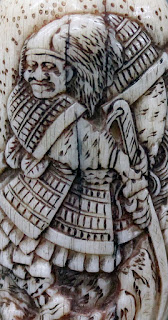 |
|
Scrimshaw Snuff Box, c. 1870
United States
Sperm whale ivory, silver and ink
2011.25.18
Gift of Dr. and Mrs. Burton W. Fink
|
Snuff Bottle, date unknown
Kenya
Wood, metal and horn
2013.7.9
Gift of Doris L. Buck
|
Snuff Bottle, late 20th Century
Japan
Antler
97.11.2
Gift of Dr. Murray and Brett Via
|
|
Around the World
At the height of its popularity, snuff was used throughout the world. The powder, ground from tobacco and usually mixed with aromatic additives, was first ingested nasally by the indigenous peoples of the New World. In the late 15th Century, the Spanish encountered its use in the Caribbean and amazed by its stimulating effects brought it back to the Old World. Less than 100 years later snuff was a trade commodity, and had already reached Japan by way of Portuguese traders. Though it has now fallen out of popularity, its once prolific nature makes it an interesting case study as snuff and the objects created to contain and consume it can be found in cultures across the globe. An examination of snuff bottles from Kenya, Japan, and the United States indicates that available mediums could affect snuff usage, and that how snuff was used differently by three entirely disparate cultures affected snuff bottle design.
 |
| Alternate view of 2011.25.18. |
Horning In
 |
| Detail of 2013.7.9's chain. |
The immediate differences and similarities between the three bottles lies in their shape and mediums. The Kenyan snuff bottle was made by either the Kamba and Kikuyu people, the works of which are difficult to distinguish from one another due to the regular trade which took place between them. The main body is carved from wood with carved horn affixed by nails to the top to create an aperture. Interestingly, in neighboring Tanzania many snuff containers are fashioned out of gourds and the ovoid wooden body of this bottle is reminiscent of this shape. Throughout the world metal, porcelain, stone, and organic materials were often used to create snuff containers. Particularly though, the organic materials retained the original shape of the medium rather than being reformed. In the United States, where snuff lacked much of the pomp it received in Europe, containers were crafted from any material which could be made to be airtight, so that the tobacco itself could be preserved. When two disparate sociological and economic phenomena met, as they did with snuff usage and the New England whaling industry, inventive mediums such as sperm whale teeth were hollowed out, capped with silver, and used to hold snuff. The gently curving conical shape is kept for its novelty, even though the utility of the container suffers for it. The same is the case with this surprisingly contemporary Japanese snuff bottle. Like both other bottles we see that its shape, in this case slender and cylindrical, is a byproduct of its medium, stag antler. In Japan, antler was commonly used for netsuke and other traditional arts and here it was uniquely repurposed for holding snuff. Ivory and horn were also commonly used for snuff bottles throughout Africa, especially in Angola and Mozambique, indicating that aspects of each medium were unique to their geography, but also universal.
 |
Bananaleaf snuff packets from Kenya.
2013.7.8.1-.2
Gift of Doris L. Buck |
Message in a Bottle
As the medium could determine shape, usage tended to determine various design elements as well. Among the Kikuyu snuff was regarded as a “consolation for middle life and old age.” Past a certain point in one’s life it was an urbane constant, worn regularly enough to merit a metal chain. Comparatively, in much of the world snuff usage was described as somewhat theatrical. The use of the spoon especially was unnecessary in dry usage, and led to critics condemning various European methods of consumption as being ostentatious. Perhaps due to the conjured image of ruffled, powdered-wigged European nobility, in America, nasally ingesting snuff became so unpopular that it was largely phased out. Whether the horn snuff bottle was used for the more popular moist snuff or simply something of an outlier in the mid 19th Century is unclear. Chinese and Japanese snuff was usually also snorted by spoon, and bottles were almost always made with spoons connected to the underside of the cap as seen with the Japanese snuff bottle. Heavy usage of this bottle has stained the interior a deep brownish red.
Message on a Bottle
The designs on the American and Japanese snuff bottles each depict characteristic national motifs and themselves speak volumes. The patriotic sentiment imparted by the eagle and shield, an extremely popular subject for many of the scrimshaw pieces made by New England carvers, likely meant that the snuff container would sell well. Made in the late 20thCentury, the Japanese snuff container harkens back to a popular romantic figure in Japanese history, the samurai. This may be intended to appeal to a foreign audience as export art. Contrasted against the undecorated exterior of the Kenyan snuff bottle, it is evident that only one of these was not made to sell.
 |
| Detail of 97.11.2. |
Text and images may be under copyright. Please contact Collection Department for permission to use. Information subject to change upon further research.





Comments